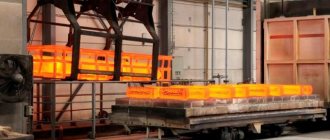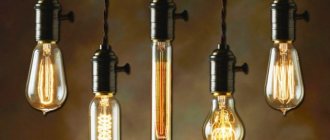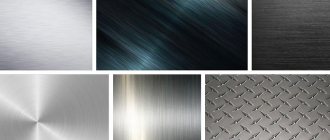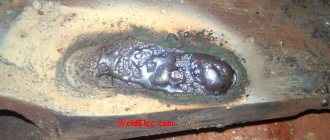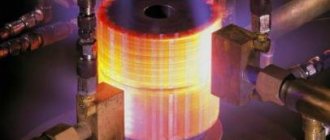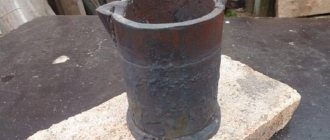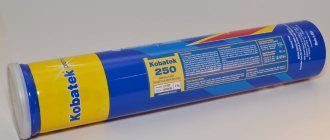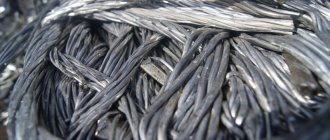Aluminum corrosion is the destruction of metal under the influence of the environment.
For the reaction Al 3+ +3e → Al, the standard electrode potential of aluminum is -1.66 V.
The melting point of aluminum is 660 °C.
The density of aluminum is 2.6989 g/cm 3 (under normal conditions).
Aluminum, although an active metal, has fairly good corrosion properties. This can be explained by the ability to passivate in many aggressive environments.
The corrosion resistance of aluminum depends on many factors: the purity of the metal, the corrosive environment, the concentration of aggressive impurities in the environment, temperature, etc. The pH of solutions has a strong influence. Aluminum oxide forms on the metal surface only in the pH range from 3 to 9!
The corrosion resistance of Al is greatly influenced by its purity. For the manufacture of chemical units and equipment, only high-purity metal (without impurities), for example, AB1 and AB2 aluminum, is used.
Corrosion of aluminum is not observed only in those environments where a protective oxide film is formed on the surface of the metal.
When heated, aluminum can react with some non-metals:
2Al + N2 → 2AlN – interaction of aluminum and nitrogen with the formation of aluminum nitride;
4Al + 3С → Al4С3 – reaction of interaction of aluminum with carbon with the formation of aluminum carbide;
2Al + 3S → Al2S3 – interaction of aluminum and sulfur with the formation of aluminum sulfide.
Corrosion of aluminum in air (atmospheric corrosion of aluminum)
Aluminum, when interacting with air, becomes passive. When pure metal comes into contact with air, a thin protective film of aluminum oxide instantly appears on the aluminum surface. Further, film growth slows down. The formula of aluminum oxide is Al2O3 or Al2O3•H2O.
The reaction of aluminum with oxygen:
The thickness of this oxide film ranges from 5 to 100 nm (depending on operating conditions). Aluminum oxide has good adhesion to the surface and satisfies the condition of continuity of oxide films. When stored in a warehouse, the thickness of aluminum oxide on the metal surface is about 0.01 - 0.02 microns. When interacting with dry oxygen – 0.02 – 0.04 microns. When heat treating aluminum, the thickness of the oxide film can reach 0.1 microns.
Aluminum is quite resistant both in clean rural air and in an industrial atmosphere (containing sulfur vapor, hydrogen sulfide, ammonia gas, dry hydrogen chloride, etc.). Because sulfur compounds do not have any effect on the corrosion of aluminum in gas environments - it is used for the manufacture of sour crude oil processing plants and rubber vulcanization devices.
Corrosion of aluminum and methods of its protection
Aluminum and its alloys are characterized by excellent resistance to various types of damage. However, despite this, corrosion of aluminum is not such a rare phenomenon. Various forms of corrosion represent the main cause of deterioration of these materials. To combat destructive processes, it is imperative to understand the factors that cause their occurrence.
Aluminum corrosion is a reaction that takes place between the metal and its environment. This process can be of either natural or chemical origin. The most common form of metal destruction is the appearance of rusting processes on its surface.
A special feature of all types of metals is their ability to react with water and the environment. The only difference for each type of metal is the intensity of this process. For example, for noble metals such as gold, the rate of such a reaction will not be too fast, but iron, including aluminum, will react to influences of this nature quite quickly.
Two factors can be distinguished that have a direct impact on the intensity of the corrosion process. One of them can be called the degree of aggressiveness of the environment, and the second is the metallurgical or chemical structure. The atmosphere that surrounds us is always characterized by a certain level of humidity. In addition, it is characterized by a certain level of pollution and waste.
If we consider that the properties of the atmosphere are often determined by the region and the degree of industrialization, today we can distinguish:
- rural areas (low pollution and average humidity);
- coastal areas (moderate pollution and high humidity);
- urban area (average level of humidity and average level of decay products of liquid fuel, sulfur and carbon oxides);
- industrial and industrial areas (large amounts of sulfur, carbon oxides and acids, as well as average humidity levels)
For most cases, inorganic acids, even at low concentrations, will be able to dissolve aluminum. And even a natural aluminum oxide film cannot provide sufficient protection against the occurrence of corrosive processes.
The most powerful solvents are fluorine, potassium and sodium. In addition, aluminum is characterized by rather low resistance to chlorine and bromine compounds. Lime and cement mortars are very aggressive to various aluminum metal alloys.
There are several types of corrosion of aluminum and its alloys:
- Superficial. This type of destruction occurs most often and is the least harmful. It is easiest to notice on the surface. This makes it possible to use safety precautions in a timely manner. Surface damage is very common on anodized profiles for construction.
- Local. Such damage appears in the form of shapes, depressions and spots. This type of corrosion can be of the surface or intercrystalline type. Destructions of this nature are especially dangerous because they are quite difficult to detect. Such corrosion very often destroys hard-to-reach parts of structures and assemblies.
- Thread-like or filigree. This type of aluminum failure often appears under organic-type coatings, as well as at the boundary surfaces of processing. Filament-like corrosion occurs at weakened areas of damaged organic coating or at the edges of holes;
Quite often, the natural anti-corrosion abilities of aluminum and its alloys are not enough to protect against destruction. And a long period of operation of products made from these metals will necessarily require the use of additional protection methods. The most common methods of protecting metals from corrosion include:
- anodizing oxidation (research by German specialists shows that this type of protection is used by 15% of the total production of building profiles in the world);
- coating of metal surfaces with powder compositions;
- protection against contact with other metals
Anodizing
Anodized coating is a coating that creates a durable aluminum oxide film on the surface of aluminum that is resistant to aggressive environments. This treatment makes it possible to create a layer of film on the surface of the metal that simply does not allow aluminum to come into contact with the external environment and protects it from oxidation processes.
Corrosion of aluminum in acids
As the purity of aluminum increases, its resistance to acids increases.
Corrosion of aluminum in sulfuric acid
Sulfuric acid (has oxidizing properties) in medium concentrations is very dangerous for aluminum and its alloys. The reaction with dilute sulfuric acid is described by the equation:
Concentrated cold sulfuric acid has no effect. And when heated, aluminum corrodes:
In this case, a soluble salt is formed - aluminum sulfate.
Al is stable in oleum (fuming sulfuric acid) at temperatures up to 200 °C. Due to this, it is used for the production of chlorosulfonic acid (HSO3Cl) and oleum.
Corrosion of aluminum in hydrochloric acid
Aluminum or its alloys quickly dissolve in hydrochloric acid (especially when the temperature rises). Corrosion equation:
Solutions of hydrobromic (HBr) and hydrofluoric (HF) acids act similarly.
Corrosion of aluminum in nitric acid
A concentrated solution of nitric acid has high oxidizing properties. Aluminum in nitric acid at normal temperatures is extremely resistant (resistance is higher than that of stainless steel 12Х18Н9). It is even used to produce concentrated nitric acid by direct synthesis.
When heated, corrosion of aluminum in nitric acid proceeds according to the reaction:
Corrosion of aluminum in acetic acid
Aluminum is quite resistant to acetic acid of any concentration, but only if the temperature does not exceed 65 °C. It is used to produce formaldehyde and acetic acid. At higher temperatures, aluminum dissolves (with the exception of acid concentrations of 98 - 99.8%).
Aluminum is stable in bromic and weak solutions of chromic (up to 10%), phosphoric (up to 1%) acids at room temperature.
Citric, butyric, malic, tartaric, propionic acids, wine, and fruit juices have a weak effect on aluminum and its alloys.
Oxalic, formic, and organochlorine acids destroy metal.
The corrosion resistance of aluminum is greatly influenced by vapor and liquid mercury. After a short contact, the metal and its alloys intensively corrode, forming amalgams.
Aluminum oxidation
Aluminum oxidation occurs at direct current under a voltage of 250 V. The protective film is grown at room temperature with water cooling. No pulse source required. The films are obtained dense and durable within 45-60 minutes.
The density and color of the oxide coating are affected by the temperature of the electrolyte:
- low temperature forms a dense film of bright color;
- increased - forms a loose film that requires further painting.
Aluminum can be protected from corrosion by an electrochemical reaction. The process is divided into several stages:
1. At the preparation stage, the aluminum product is degreased by immersing it in a solution of oxalic acid.
2. After washing with water, immerse in an alkaline solution to remove the unevenly formed oxide layer.
3. For additional coloring, aluminum products are immersed in appropriate salt solutions. To fill the formed pores, the metal material is treated with steam.
4. The product is then dried. Anodic oxidation can be carried out using alternating current.
To protect against corrosion, chemical oxidation is used - it is less expensive and does not require special electrical equipment and qualifications of performers. A simple chemical composition is used.
During the aluminizing process, the resulting oxide film 3 microns thick has a light green color, has high electrical insulating properties, is non-porous, and does not stain.
Corrosion of aluminum occurs due to nearby metals that have oxidized. Isolation helps prevent this process. These can be gaskets made of rubber, bitumen, paronite. When covering with rust, varnish and other insulating materials are used. There are no other ways to get rid of this problem yet.
Natural oxide coating
The natural surface of aluminum, which is created during the manufacturing of an aluminum product, such as extrusion, rolling or casting, has high resistance to corrosion in most types of environments. This occurs because a fresh aluminum surface spontaneously and instantly forms a thin but very effective oxide layer that prevents further oxidation of the metal.
This oxide film is impermeable and, unlike the oxide films of other metals, such as iron, is very firmly “attached” to the base metal. In case of any mechanical damage, this film is instantly restored and healed.
The natural oxide layer is the main reason for aluminum's good resistance to corrosion. This coating is resistant in environments with acidity - pH value - from 4 to 9.
Interaction of aluminum with complex substances
with water
As mentioned above, a stable and durable oxide film of Al2O3 prevents aluminum from oxidizing in air. The same protective oxide film makes aluminum inert towards water. When removing the protective oxide film from the surface by methods such as treatment with aqueous solutions of alkali, ammonium chloride or mercury salts (amalgiation), aluminum begins to react vigorously with water to form aluminum hydroxide and hydrogen gas:
2Al + 6H2O = 2Al(OH)3 + 3H2↑
with metal oxides
After igniting a mixture of aluminum with oxides of less active metals (to the right of aluminum in the activity series), an extremely violent, highly exothermic reaction begins. Thus, in the case of interaction of aluminum with iron (III) oxide, a temperature of 2500-3000°C develops. As a result of this reaction, high-purity molten iron is formed:
2AI + Fe2O3 = 2Fe + Al2O3
This method of obtaining metals from their oxides by reduction with aluminum is called aluminothermy or aluminothermy.
with non-oxidizing acids
The interaction of aluminum with non-oxidizing acids, i.e. with almost all acids, except concentrated sulfuric and nitric acids, leads to the formation of an aluminum salt of the corresponding acid and hydrogen gas:
a) 2Al + 3H2SO4(dil.) = Al2(SO4)3 + 3H2↑
2Al0 + 6H+ = 2Al3+ + 3H20;
b) 2AI + 6HCl = 2AICl3 + 3H2↑
with oxidizing acids
-concentrated sulfuric acid
The interaction of aluminum with concentrated sulfuric acid under normal conditions and at low temperatures does not occur due to an effect called passivation. When heated, the reaction is possible and leads to the formation of aluminum sulfate, water and hydrogen sulfide, which is formed as a result of the reduction of sulfur, which is part of sulfuric acid:
Such a deep reduction of sulfur from the oxidation state +6 (in H2SO4) to the oxidation state -2 (in H2S) occurs due to the very high reducing ability of aluminum.
- concentrated nitric acid
Under normal conditions, concentrated nitric acid also passivates aluminum, which makes it possible to store it in aluminum containers. Just as in the case of concentrated sulfuric acid, the interaction of aluminum with concentrated nitric acid becomes possible with strong heating, and the reaction predominantly occurs:
- dilute nitric acid
The interaction of aluminum with diluted nitric acid compared to concentrated nitric acid leads to products of deeper nitrogen reduction. Instead of NO, depending on the degree of dilution, N2O and NH4NO3 can be formed:
8Al + 30HNO3(dil.) = 8Al(NO3)3 +3N2O↑ + 15H2O
8Al + 30HNO3(ultra dilute) = 8Al(NO3)3 + 3NH4NO3 + 9H2O
What is electrochemical corrosion and can it occur on an aluminum sheet?
Most often, the appearance of electrochemical corrosion is provoked by galvanic couples. Damage occurs at the junction of two different alloys. In this case, the rust will be clearly visible. The important point is that only one metal deteriorates, and the second is the source of the corrosion process. In order not to be afraid of electrochemical corrosion, you need to use a magnesium alloy. Due to electrochemical rust, experts do not recommend using ordinary iron when in contact with an aluminum body.
Construction material for low temperatures – aluminum
Aluminum alloys are a very important class of structural metals for use at sub-zero and even cryogenic temperatures. They are used in parts to work at temperatures as low as -270 °C. At subzero temperatures, most aluminum alloys exhibit only minor changes in their strength properties.
The tensile strength (tensile strength) and yield strength of aluminum alloys can only decrease slightly with decreasing temperature, and the impact strength remains approximately constant. Therefore, aluminum is a useful material for many low temperature applications.
The main limiting factor for the widespread use of aluminum alloys in cryogenic technology is their rather low elongation compared to some austenitic-ferritic steels. Therefore, in critical applications with increased safety requirements, these steels are still used.
§ 2. Aluminum
In terms of abundance in nature, aluminum ranks fourth (after O, H and Si), and it accounts for about 5.5% of the total number of atoms in the earth’s crust. The main mass of aluminum is concentrated in aluminosilicates (X § 3). An extremely common product of the destruction of rocks formed by them is clay, the main composition of which (corresponding to kaolin) corresponds to the formula Al2 O3 * 2SiO2 * 2H2 O. Of the other aluminum minerals, the most important are bauxite (Al2 O3 xH2 O) and cryolite (AlF3 –3NaF) .
1) Clay is the main raw material of the ceramic industry. The so-called coarse ceramics covers the production of bricks, various fireproof (chamotte, etc.) and acid-resistant (clinker, etc.) materials, pottery (pottery), tiles, tiles, etc., and fine ceramics - production of porcelain and earthenware.
Elemental aluminum is obtained by electrolysis of a solution of Al2O3 in molten cryolite. The process is carried out at temperatures of about 1000°C in electric furnaces, with oxygen being released at the anode and aluminum at the cathode. The latter accumulates at the bottom of the furnace, from where it is periodically released.
Schematically shown in Fig. 150, a furnace for smelting aluminum consists of an iron box, the inner walls and bottom of which are lined with a thick carbon lining K, which serves as a cathode during electrolysis. A massive carbon electrode A is used as an anode. During operation of the furnace, Al2 O3 is periodically added to it, and the molten metal is removed. Aluminum smelting is very energy-intensive: each ton of metal requires about 20 thousand kWh of electricity.
2) Since purifying aluminum from impurities is very difficult, it is necessary that the starting materials themselves to obtain it be pure. Cryolite is usually prepared artificially by jointly dissolving Al(OH)3 and soda in hydrofluoric acid according to the reaction
3Na2 CO3 + 2Al(OH)3 +12HF = 2Na3 AlF6 + 3CO2 + 9H2 O
Natural bauxites, which contain 40–60% Al2 O3 and a number of impurities (SiO2, Fe2 O3, etc.), are subjected to preliminary chemical processing in order to isolate sufficiently pure aluminum oxide from them (containing no more than 0.2% SiO2 and 0.04% Fe2 O3). Methods for such processing strongly depend on the composition of the original bauxite and are quite complex.
Aluminum is a silvery-white, fairly hard metal with a density of 2.7, melting at 660° and boiling at 2350°C. It is characterized by high ductility and high electrical conductivity (0.6 of the electrical conductivity of copper). This is due to its use in the production of electrical wires.
The use of aluminum in the form of various alloys, along with good mechanical properties and characterized by their lightness, is much more widespread. The so-called duralumin is especially important (approximate composition: 94% Al, 4% Cu, 0.5% each Mg, Mn, Fe and Si). It is valuable because, with equal strength, products made from it are almost three times lighter than steel ones. Not to mention the aviation industry, for which the lightness of the material is especially important, the lightweighting of metal structures is of enormous importance for a number of areas of technology.
This becomes especially clear if we take into account that, for example, in a loaded freight car, about a third of the total weight comes from the materials from which the car itself is made, and in passenger cars, up to 95% of the total load falls on their own weight. It is obvious that even partial replacement of steel with duralumin gives a huge techno-economic effect. In this regard, and also due to the presence in nature of practically
inexhaustible reserves of aluminum, it is sometimes called the “metal of the future.” The possibility of a widespread partial replacement of the main metal of modern technology - iron - is limited mainly by the relatively high cost of aluminum.
3) In addition to the noted areas of application of aluminum, it is widely used for making household utensils, etc. At 100–150 ° C, aluminum is so ductile that foil less than 0.01 mm thick can be produced from it. Such foil is widely used for making electrical capacitors and for wrapping certain products. A pure aluminum surface reflects about 90% of the radiation incident on it (not only visible, but also infrared and ultraviolet). By applying aluminum to glass (by vacuum deposition), high-quality mirrors can be obtained that reflect rays of different wavelengths very evenly. Fine aluminum powder is used to make weather-resistant silver paint. The annual world production of aluminum is currently about 3 million tons (compared to 8 thousand tons in 1900).
In air, aluminum is immediately covered with a thin (0.00001 mm) but very dense film of oxide, which protects the metal from further oxidation. In this regard, the surface
it usually has a matte rather than shiny appearance. When finely crushed aluminum is heated, it burns vigorously in air. Its interaction with sulfur proceeds similarly. The combination with chlorine and bromine occurs at ordinary temperatures, and with iodine - upon heating. At very high temperatures, aluminum also combines directly with nitrogen and carbon. On the contrary, it does not interact with hydrogen.
Aluminum is quite resistant to water. Highly diluted and very concentrated HNO3 and H2 SO4 have almost no effect on aluminum, whereas at medium concentrations of these acids it gradually dissolves. Pure aluminum is quite resistant to hydrochloric acid, but ordinary industrial metal dissolves in it (Fig. 151).
Aluminum is easily soluble in strong alkalis according to the reaction, for example:
2Al + 2NaOH + 2H2 O = 2NaAlO2 + 3H2
In the stress series it is located between Mg and Zn. In all its stable compounds, aluminum is trivalent.
4) The ease of dissolving aluminum in strong silica is due to the removal of the protective oxide film from it according to the scheme: Al2 O3 + 2OH– = 2AlO2– + H2 O. Since in the series of voltages Al is located significantly to the left of hydrogen, the exposure of a clean metal surface is immediately accompanied by reactions according to the schemes :
2Al+ 6H+ (from water) = 2Al3+ + 3H2
And
2Аl3+ + 8ОН– = 2АlO2 + 4Н2 О
the equilibrium of the first of them constantly shifts to the right at the expense of the second. The dissolution of other active metals with amphoteric hydroxides - Sn, Zn, etc. - proceeds similarly in alkalis.
The combination of aluminum with oxygen is accompanied by an enormous release of heat (399 kcal/mol Al2O3), significantly greater than in the case of many other metals. In view of this, when a mixture of the oxide of the corresponding metal with aluminum powder is heated, a violent reaction occurs, leading to the release of free metal from the taken oxide. The reduction method using Al (aluminothermy) is often used to obtain a number of elements (Cr, Mn, V, etc.) in a free state.
Aluminothermy is sometimes also used for welding individual steel parts to each other, in particular the joints of tram rails. The mixture used (“thermite”) usually consists of fine powders of aluminum and ferrous oxide (Fe3 O4). It is ignited using a fuse made from a mixture of Al and BaO2. The main reaction follows the equation.
8Аl+ 3Fe3 O4 = 4А12 О3 + 9Fe + 795 kcal
and the temperature develops to about 3500°C.
Aluminum oxide is a white, very refractory and water-insoluble mass. Natural Al2O3 (mineral corundum), as well as those obtained artificially and then highly calcined, are distinguished by high hardness and insolubility in acids. Aluminum oxide (so-called alumina) can be converted into a soluble state by fusion with alkalis.
5) Usually, natural corundum contaminated with iron oxide, due to its extreme hardness, is used for the manufacture of grinding wheels, whetstones, etc. In its finely crushed form, it is called emery and is used for cleaning metal surfaces and making sandpaper. For the same purposes, aluminum oxide, obtained by fusing bauxite (technical name - alundum), is often used.
Transparent crystals of corundum, beautifully colored with minor impurities of other substances, are used as precious stones: red ruby, blue sapphire, etc. Currently, they are made artificially by melting and subsequent crystallization of AI2 O3 in the presence of appropriate impurities.
Due to the insolubility of Al2O3 in water, the hydrate [Al(OH)3] corresponding to this oxide can be obtained only indirectly (from salts). It is a voluminous gelatinous white sediment, practically insoluble in water, but easily soluble in acids and strong alkalis.
Aluminum hydroxide is therefore amphoteric in nature. However, its basic and especially acidic properties are rather weakly expressed. Aluminum hydroxide is insoluble in excess NH4 OH.
When Al(OH)3 reacts with strong alkalis, the corresponding aluminates are formed, for example, according to the scheme:
Al(OH)3 + KOH = KAlO2 + 2H2 O
Aluminates of the most active monovalent metals are highly soluble in water, but due to strong hydrolysis, their solutions are stable only in the presence of a sufficient excess of alkali. Aluminates, produced from weaker bases, are hydrolyzed in solution almost completely and therefore can only be obtained by the dry method (by fusing Al2O3 with oxides of the corresponding metals). Most of them are insoluble in water.
6) Aqueous solutions of aluminates contain [Al(OH)4 ]–, [Al(OH)5 ]2– and [Al(OH)6 ]3– ions. Apparently, aluminates obtained from solutions are also constructed according to the same type, while when oxides are fused, anhydrous salts are formed, the composition of which is derived from HAlO3.
With acids Al(OH)3 forms salts containing colorless Al3+ ions in solution. Derivatives of most strong acids are highly soluble in water, but are quite significantly hydrolyzed and therefore their solutions exhibit an acidic reaction. Soluble salts of Al3+ and weak acids are even more hydrolyzed.
In the series of aluminum halides, AlF3 is very different in properties from its analogues. Produced dryly (for example, by heating Al2O3 in HF vapor), aluminum fluoride is a colorless crystalline powder that melts only at 1040 °C. It is practically insoluble in water.
Compounds of aluminum with chlorine, bromine and iodine are colorless and fusible. They are highly reactive and highly soluble not only in water, but also in many organic solvents. In aqueous solution they are all highly hydrolyzed. Being noticeably volatile even under normal conditions, AlCl3, AlBr3 and AlJ3 smoke in humid air (due to hydrolysis).
With halide salts of a number of monovalent metals, aluminum halides form complex compounds, mainly of the M3 [AlF6] and M[AlG4] types (where G = Cl, Br or J). The tendency to addition reactions is generally very pronounced in the halides under consideration, especially in AlCl3. This is precisely why its most important technical application as a catalyst (in oil refining and organic syntheses) is connected.
7) Some constants of aluminum halides are compared below:
The vapor densities of AlCl3, ALBr3 and AJ3 at relatively low temperatures more or less accurately correspond to the double formulas - Al2 Г6. The spatial structure of these molecules corresponds to two tetrahedra with a common edge (Fig. 152). Each aluminum atom is bonded to four halogen atoms, and each of the central halogen atoms is bonded to both aluminum atoms. Of the two bonds of the central halogen, one is donor-acceptor (IX § 2 add. 1), with aluminum functioning as an acceptor.
Aluminum sulfate is colorless and easily soluble in water. It is usually isolated in the form of crystalline hydrate Al2 (SO4 )3 18H2 O. With sulfates of a number of monovalent metals, aluminum sulfate forms colorless complex salts of the type M[Al(SO4 )2 ] 12H2 O. Being quite stable in the solid state, these salts (t n. alum) in solution are almost completely dissociated into their individual constituent ions. In addition to aluminum, complex sulfates of the alum type are also known for a number of other trivalent metals (E = Cr, Fe, V, etc.). As monovalent cations (M), their composition may include K+, Na+, NH4+ and some others.
Of the other aluminum derivatives, mention should be made of its acetic acid salt [Al(CH3 COO)3], used in dyeing fabrics (as a mordant) and in medicine (lotions and compresses). This salt is known only in solution (where it is highly hydrolyzed). Aluminum nitrate is readily soluble in water. Aluminum phosphate is insoluble in water (and acetic acid), but soluble in strong acids and alkalis.
Aluminum sulfide (AI2S3) can be obtained by the interaction of elements and appears as white needles (mp 1100 °C). Powdered aluminum combines with nitrogen above 800 °C. Aluminum nitride (AlN) is a white powder that does not change when heated to approximately 2000 °C, and above this temperature begins to decompose into elements. It slowly decomposes with water according to the equation:
AlN + 3H2 O = Al(OH)3 + NH3
Yellow aluminum carbide (Al4 C3) is formed when a mixture of aluminum oxide and carbon is heated to approximately 2000 °C. Water decomposes it according to the equation: Al4 C3 + 12H2 O = 4Al(OH)3 + 3CH4.
9) Although aluminum does not react chemically with hydrogen, aluminum hydride can be obtained indirectly in the form of a white amorphous mass. It is a highly polymerized product with the composition (AlH3)x. When heated above 100 °C, aluminum hydride decomposes into elements.
More on the topic:
- ALUMINUM - chemical encyclopedia
- Aluminum - a guide to substances
Aluminum production
The main raw material for aluminum production is bauxite, an ore that is mainly hydrated aluminum oxide Al2O3Х2H2O. The world leader in aluminum production is the USA, followed by Russia, Canada and Australia. Aluminum is best known as a raw material for the production of alloys used for the manufacture of food containers (cans, cylinders, jars, etc.), light kitchen utensils and other household utensils. Crude aluminum was first isolated by H. Oersted in 1825, although back in 1807 H. Davy discovered an unknown metal when treating clay with sulfuric acid. Davy was unable to isolate the metal from the compounds, but called it aluminum (from the Latin alumen - alum), and its oxide - alumina (alimina); soon this name of the metal, by analogy with the names of other metals, was changed to “aluminum”, which became generally accepted.
Aluminum extraction technologies
Chemical element No. 13 is the most abundant in nature, its content in the earth's crust is about 9%. The metal is a component of more than 250 minerals, mainly aluminosilicates, that make up the earth's crust.
The product of destruction of formations is clay, consisting of kaolinite. It sometimes contains an admixture of iron, which gives it a brown color.
Despite the fact that there are many mineral formations in nature, not all of them are ore material for extracting a valuable component. Bauxite ores, which contain industrial concentrations of the metal, are used for mining.
Aluminum forms the mineral corundum, which is inferior in hardness to diamond. The content of impurities of chromium, titanium and iron oxide in the aluminum compound Al2O3 forms the precious minerals ruby and sapphire.
- The valuable component is extracted from enriched ore by electrolysis of a solution of the oxide in a molten compound of fluorine, sodium and aluminum (cryolite). This method allows electrolysis to be carried out at temperatures below 1000 °C.
- Due to the low melt density, the liquid compound sinks to the bottom, making removal easier. When electrolytically producing metal, pure oxide Al2O3 is first isolated from alumina.
- Before use, the ore is purified from impurities of iron, silicon, and calcium compounds. When bauxite is fired, the water contained in the minerals evaporates. The resulting material is separated by exposing the compound to carbon dioxide.
The chemical method is widely used in the production of pure aluminum. It consists of treating the ore with NaOH alkali at a temperature of 220 °C to produce Al (OH)2. As a result of hydrolysis of the solution, aluminum oxidizes and its compound precipitates.
Aluminum is produced chemically
Then, as a result of using carbon dioxide, soda and potash are obtained. To obtain a chemically pure material, the technical material is heated in AlF3 vapor followed by cooling. As a result of temperature changes, pure aluminum is released.
The production of high-purity metal involves the development of new technologies and the creation of conditions under which the metal can oxidize without additional energy consumption.
One of the new methods involves the synthesis of high-purity aluminum oxide by the catalytic oxidation of metal with oxygen in water using ultrasonic vibrations, the development of an autocatalytic method for producing submicron powder, followed by the formation of high-density briquettes.
Application of aluminum
Since ancient times, alum has been used in medicine as an astringent, in dyeing for mordant, and for tanning leather. Alum is often called mixed sulfates of mono- and trivalent metals, such as aluminum and potassium (the mineral solvaterite). The Roman scientist Pliny the Elder (1st century AD) in his Natural History mentions alum as a salt whose properties were studied by alchemists. The Egyptians were the first to use alum for tanning leather and for medicinal purposes; they, as well as the Lydians, Phoenicians and Jews, knew that some dyes, such as indigo and cochineal, were better preserved if they were mixed or soaked in alum. Crystalline aluminum oxide, found naturally as corundum, is used as an abrasive due to its high hardness. Ruby and sapphire are varieties of corundum colored by impurities and are gemstones.
Applications of aluminum metal
Aluminum is one of the lightest structural metals. Alloys obtained from aluminum after heat treatment, along with low density, are distinguished by high strength and other important mechanical properties, which makes aluminum indispensable for the manufacture of vehicle parts (pistons and crankcases, blocks and cylinder heads of aircraft and automobile engines, bearings, power trains and casing fuselages, etc.).
Aluminum is easily drawn and drawn, which is used in the production of food containers. The electrical conductivity of aluminum is approx. 61% of the electrical conductivity of copper, but aluminum is three times less dense.
The combination of good conductivity with high corrosion resistance in air expands the use of aluminum cables, often reinforced with steel, for high-voltage power transmission. Aluminum is also distinguished by its high thermal conductivity, which is used in engines, cooling systems and other devices.
The metal is easily polished mechanically and electrolytically, so it is also used for telescope reflectors and similar purposes. Aluminum is widely used as a packaging material and has the highest recycling recovery rate among other packaging materials. Recovering aluminum recyclables allows you to save energy, since its consumption in this case is less than when producing aluminum from ore.
In 1981, the share of recovered aluminum in the production of food containers was 53.2%, and by 1991 it reached 62.4% and continues to grow. Aluminum is highly resistant to corrosion due to the formation of an oxide film on its surface and is therefore used as roofing material, sheathing, and in daylight and infrared light reflectors.
Its corrosion resistance can be further enhanced by electrolytic anodic oxidation, known as anodizing, which increases the thickness and adhesion of the oxide film. The anodized surface is easy to paint; this method is often used for architectural panels
The corrosion resistance of aluminum, combined with its beautiful appearance, ensures its widespread use in refrigeration technology. Aluminum is a strong reducing agent and is used to separate less reactive metals and as an antioxidant in the production of steel and explosives. Aluminum powder is used in finishing works.
